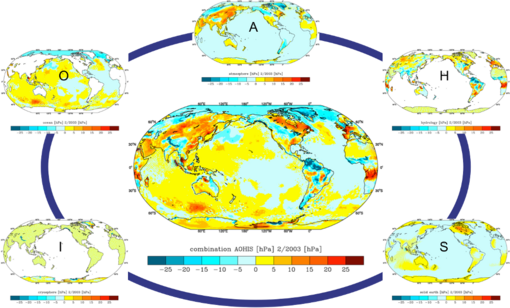Telegrafenberg
Building A20, room 316
14473 Potsdam
tel. +49 331 288-1974
Earth System Model for Gravity Mission Simulation Studies
A new synthetic model of the time-variable gravity field of the Earth suitable for satellite gravity mission simulation studies is now available. The model is an update of the ESA Earth System Model as described by Gruber et al. (2011), and is also given in spherical harmonics up to degree and order 180 for the years 1995 to 2006 with a time sampling of 6 hours. File formats and conventions follow the ICGEM standards.
The updated ESA Earth System Model features the following changes and improvements:
- Atmospheric mass anomalies from ECMWF ERA-Interim reanalysis
- Terrestrial Water Storage Variations from LSDM
- Greenland and Antarctica surface mass balance from RACMO2
- Large-scale ocean variability from OMCT (GRACE AOD1B RL05 configuration)
- Meso-scale ocean variability from the MPIOM STORM experiment
- Consistent forcing of all hydrospheric models with ECMWF ERA-Interim
- Land - Ocean - Mask identical to GRACE AOD1B RL05
- Mass fluxes are modeled implicitly by adding the sum of the mass anomalies in the atmosphere, cryosphere, and terrestrially hydrosphere additive-inversely to the ocean as globally homogeneous barystatic sea-level anomaly
- Revised spatial pattern of the Sumatra-Andaman earthquake's co- and post-seismic deformation
- Elastic Load Love Number according to the Earth’s Center of Figure (CF) frame degree 1 terms from GIA included

Reference Paper
- Dobslaw, H., Bergmann-Wolf, I., Dill, R., Forootan, E., Klemann, V., Kusche, J., Sasgen, I. (2015): The updated ESA Earth System Model for future gravity mission simulation studies. Journal of Geodesy, Vol. 89, p. 505-513, doi:10.1007/s00190-014-0787-8.
Paper describing the realistically perturbed De-Aliasing Model
AOe07:
- Shihora, L., Liu, Z., Balidakis, K. et al. Accounting for residual errors in atmosphere–ocean background models applied in satellite gravimetry. J Geod 98, 27 (2024). doi:10.1007/s00190-024-01832-7
AOerr (previous version):
- Dobslaw, H., Bergmann-Wolf, I., Forootan, E., Dahle, C., Mayer-Gürr, T., Kusche, J., Flechtner, F. (2016): Modeling of present-day atmosphere and ocean non-tidal de-aliasing errors for future gravity mission simulations. Journal of Geodesy, 90, 5, pp. 423-436, doi:10.1007/s00190-015-0884-3.
Documentation
- Dobslaw, H., Bergmann–Wolf, I., Dill, R., Forootan, E., Klemann, V., Kusche, J., Sasgen, I. (2014): Updating ESA’s Earth System Model for Gravity Mission Simulation Studies: 1. Model Description and Validation. Scientific Technical Report 14/07, GFZ German Research Centre for Geosciences, doi:10.2312/GFZ.b103-14079.
- Bergmann–Wolf, I., Dill, R., Forootan, E., Klemann, V., Kusche, J., Sasgen, I., Dobslaw, H. (2014): Updating ESA’s Earth System Model for Gravity Mission Simulation Studies: 2. Comparison with the Original Model. Scientific Technical Report 14/08, GFZ German Research Centre for Geosciences, doi:10.2312/GFZ.b103-14088.
- Bergmann-Wolf, I., Forootan, E., Klemann, V., Kusche, J., Dobslaw, H. (2015): Updating ESA’s Earth System Model for Gravity Mission Simulation Studies: 3. A Realistically Perturbed Non-Tidal Atmosphere and Ocean De-Aliasing Model. Scientific Technical Report 14/09, GFZ German Research Centre for Geosciences, 62 p., doi:10.2312/GFZ.b103-14091.

